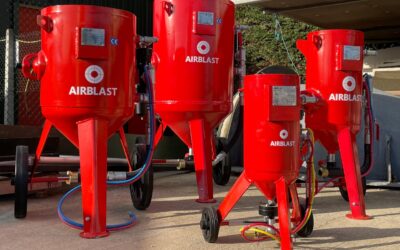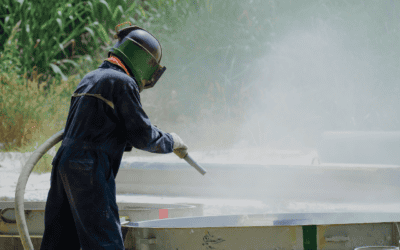Blasting in Cold Weather: Key Challenges and How to Overcome Them
As temperatures drop, abrasive blasting becomes more challenging.
Cold weather doesn’t just make work uncomfortable for operators – it directly impacts equipment performance, abrasive behaviour, and the success of coating applications. Failing to plan for winter conditions can lead to costly rework, unexpected downtime, and compromised results. In this blog, we’ll look at the main considerations for abrasive blasting in cold weather, and how to prepare your equipment and processes for the winter months.
Equipment in low temperatures
Blasting equipment is designed to operate under tough conditions, but cold weather puts additional strain on critical components. If equipment fails in winter, blasting becomes inconsistent – and that inconsistency carries through to the coating stage.
- Hoses and seals: Rubber and plastic components can become brittle, increasing the risk of cracks or leaks. Regular inspections are vital to spot wear before it causes failures.
- Valves and fittings: Low temperatures can cause stiffness, making valves harder to operate and more prone to seizing. Keeping spares on hand reduces downtime.
- Air compressors: Moisture in compressed air systems can freeze in pipes and fittings, restricting airflow and damaging equipment. Installing moisture separators and ensuring effective air drying is particularly important in winter.
Installing moisture separators and ensuring effective air drying is particularly important in winter. According to ISO 8573 (compressed air quality standards), moisture control is critical to prevent contamination and equipment damage.
Regular servicing and preventative maintenance are especially important when blasting in cold climates. Without reliable equipment performance, blasting quality suffers – and coatings applied to poorly prepared surfaces are far more likely to fail.
Looking for reliable blasting equipment built to withstand demanding conditions? Explore our full range of hoses, compressors, and accessories here.
Abrasive performance in winter
Temperature and humidity directly affect how abrasives work, and when media performance drops, blasting outcomes decline too. This leads to weak surface profiles that prevent coatings from bonding correctly.
- Moisture contamination: Damp abrasives clump together, block hoses, and deliver uneven blasting. Even a small amount of moisture reduces efficiency and wastes media. Moisture left behind on the surface also undermines coating adhesion.
- Storage issues: Leaving abrasives exposed in winter risks freezing or absorbing moisture. Always store media in dry, sheltered environments.
- Flow consistency: Abrasives may behave differently in colder conditions and can change flow rates, making it harder to achieve the consistent anchor profile coatings required for long-term durability. Testing flow before starting a job ensures consistent results.
Keeping abrasives dry, flowing freely, and stored correctly is essential – not just for efficiency, but to ensure surfaces are clean and correctly profiled for coating application.
Keep your projects running smoothly this winter with high-quality abrasive media. Browse our abrasive range on our website.
Coating application challenges
Blasting quality has a direct impact on coating performance, and cold weather makes achieving the right surface preparation much harder. If blasting is incomplete or contaminated by moisture, coatings struggle to adhere and cure as intended.
- Adhesion problems: Low temperatures and damp surfaces can leave behind moisture, or uneven profiles from blasting. These defects prevent coatings from bonding properly, leading to premature breakdown.
- Profile inconsistency: Inconsistent abrasive flow in cold weather can produce irregular surface profiles. This reduces the coating’s ability to achieve full coverage and long-term protection.
- Extended curing times: Even if blasting is successful, coatings applied to cold substrates cure much more slowly. Without the correct profile and environmental conditions, the finish can be compromised.
To minimise these risks, ensure blasting delivers the correct surface cleanliness and profile before applying coatings. Industry standards such as ISO 8501-1 (surface cleanliness grades) highlight the importance of consistent blasting quality as the foundation for coating performance. We would recommend considering using blast rooms or booths to create a controlled environment for this.
Safety considerations
Blasting in winter isn’t only about equipment and coating quality – it also affects operator safety. Cold weather increases fatigue, reduces dexterity, and makes PPE harder to manage.
To reduce risks:
- Ensure operators have properly insulated PPE without compromising mobility.
- Provide warm break areas where teams can recover from cold exposure.
- Increase monitoring for slips, trips, and falls in icy or wet conditions.
A safer workforce is a more efficient one – and good planning helps maintain productivity even in harsh climates. For further guidance, please refer to the HSE website.
Practical tips for winter blasting
- Store abrasives in a dry, temperature-controlled space.
- Fit air dryers and moisture separators to your compressor setup.
- Check hoses, seals, and valves more frequently.
- Plan coating applications for times when temperatures meet product guidelines.
- Consider heated shelters or temporary enclosures for sensitive projects.
These steps help maintain consistent abrasive blasting conditions, even in low-temperature environments. When in doubt, refer to recognised standards such as ISO 8501-1 for surface cleanliness, which outline acceptable preparation and application conditions.
Final thoughts
Blasting in cold weather presents unique challenges, but with the right preparation, it doesn’t have to cause delays or reduce quality. By taking extra care with equipment maintenance, abrasive storage, and coating application conditions, you can ensure your winter projects stay on track.
Key takeaway: Preparation is the key to success. Anticipating the effects of cold weather on blasting helps you avoid downtime, protect your equipment, and achieve a lasting finish – even in the harshest conditions.
At Airblast Limited, we supply blasting and coating solutions to help you work effectively in every season. Contact us today to discuss your winter blasting needs.



